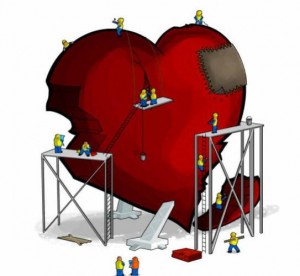"In older people there are changes in the heart and blood vessels secondary to aging and the adjustments to it.The cardiovascular system is made up of the heart and blood vessels, arteries and veins. Heart
function, as is known, consists in pumping the blood to circulate it
through the arteries to carry oxygen to the body and other nutrients
through the veins and collect waste products.
The heart consists basically of four chambers, two atria and two ventricles. The atria function as inlet chambers of blood from the veins, while the ventricles propel blood into the arteries. Passing control to each other is performed by the valves, in this way the heart works as a hydraulic pump.
Both the heart and blood vessels have a similar structure: an inner layer or inner (endocardium in the heart), a muscular layer, especially important in the ventricles and almost nonexistent in the veins, and an outer layer (adventitia) of fibrous material protecting the joint.Over time the arteries lose elasticity due to the increase in medial wall thickness of the muscle, which hinders the passage of blood through the narrowing of vessel size and facilitates the development of hypertension. Also produced a deposit of fat (cholesterol) in the intima, which calcify forming plates, which increases the size of the arterial wall stiffness and worsens.In the veins, changes are rare and occur mainly in the lower extremities. Due to the thinness of the middle layer muscle veins suffer significantly the effect of the weight of the blood column can not be compensated and if (with the movement of the legs, for example) are varicose veins.
The heart consists basically of four chambers, two atria and two ventricles. The atria function as inlet chambers of blood from the veins, while the ventricles propel blood into the arteries. Passing control to each other is performed by the valves, in this way the heart works as a hydraulic pump.
Both the heart and blood vessels have a similar structure: an inner layer or inner (endocardium in the heart), a muscular layer, especially important in the ventricles and almost nonexistent in the veins, and an outer layer (adventitia) of fibrous material protecting the joint.Over time the arteries lose elasticity due to the increase in medial wall thickness of the muscle, which hinders the passage of blood through the narrowing of vessel size and facilitates the development of hypertension. Also produced a deposit of fat (cholesterol) in the intima, which calcify forming plates, which increases the size of the arterial wall stiffness and worsens.In the veins, changes are rare and occur mainly in the lower extremities. Due to the thinness of the middle layer muscle veins suffer significantly the effect of the weight of the blood column can not be compensated and if (with the movement of the legs, for example) are varicose veins.
Multiple changes in the heart
Increased wall thickness increased left ventricular collagen and fat between muscle cells, which decrease in number.
Thickening of the lining of all cardiac chambers.
Thickening of the heart valves also calcify.
Reduction of "pacemaker" cells (heart cells responsible for creating the electricity generated by the heartbeat), tissue fibrosis electrical impulse conduction.The consequences of these changes are very important:
Decreased ability to exercise tolerance, more difficult to recover from it.
More difficult to fill both chambers of the heart (diastole) and for emptying (systole), being able to get to the heart failure.
Major difficulty for the correct opening and closing movement of the heart valves, which eventually influences the overall function of the heart pump.
Increased periods when you lose your regular heart rhythm (arrhythmias), such that the regularity of filling and emptying of the cardiac chambers is affected. Sometimes you can create eddies in the flow of blood that can facilitate the development of clots that can then travel through the arteries and block blood flow (thrombosis and embolism)"

Bibliography:
Flinterman LE, van Hylckama Vlieg A, Cannegieter SC, Rosendaal FR. Long-term survival in a large cohort of patients with venous thrombosis: incidence and predictors. PLoS Med. 2012 Jan;9(1):e1001155. Epub 2012 Jan 10. Disponible en: http://www.ncbi.nlm.nih.gov/pmc/articles/PMC3254666/?tool=pubmed
Shiraki T, Saito D. Clinical features of acute myocardial infarction in elderly patients. Acta Med Okayama. 2011 Dec;65(6):379-85. Disponible en: http://www.lib.okayama-u.ac.jp/www/acta/pdf/65_6_379.pdf
